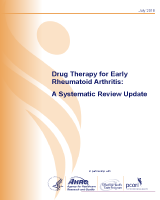| Target population (Who should be tested?) |
|---|
Patients who
Differential diagnoses vary among patients with different presentations, but may include conditions such as systemic lupus erythematosus, psoriatic arthritis, and gout. If it is unclear about the relevant differential diagnoses to consider, an expert rheumatologist should be consulted |
|
| Classification criteria for RA | Score |
|---|
Score-based algorithm:
Add score of categories: Joint involvement, serology, reactants, duration Differential diagnoses vary among patients with different presentations, but may include conditions such as systemic lupus erythematosus, psoriatic arthritis, and gout. If it is unclear about the relevant differential diagnoses to consider, an expert rheumatologist should be consulted
Score of ≥6/10 needed for classification of a patient as having definite RA
|
|
| Joint involvement |
|---|
| Joint involvement refers to any swollen or tender joint on examination, which may be confirmed by imaging evidence of synovitis; d Distal interphalangeal joints, first carpometacarpal joints, and first metatarsophalangeal joints are excluded from assessment; categories of joint distribution are classified according to the location and number of involved joints, with placement into the highest category possible based on the pattern of joint involvement |
|
| 1 large joint | 0 |
|---|
“Large joints” refers to shoulders, elbows, hips, knees, and ankles
|
|
| 2-10 large joints | 1 |
|---|
|
1-3 small joints (with or without involvement of large joints)
“Small joints” refers to the metacarpophalangeal joints, proximal interphalangeal joints, second through fifth metatarsophalangeal joints, thumb interphalangeal joints, and wrists.
| 2 |
|
| 4-10 small joints (with or without involvement of large joints) | 3 |
|---|
|
| >10 joints (at least 1 small joint) | 5 |
|---|
In this category, at least 1 of the involved joints must be a small joint; the other joints can include any combination of large and additional small joints, as well as other joints not specifically listed elsewhere (e.g., temporomandibular, acromioclavicular, sternoclavicular, etc.)
|
|
| Serology (at least 1 test result is needed for classification)†† |
|---|
Negative refers to IU values that are less than or equal to the upper limit of normal (ULN) for the laboratory and assay; low-positive refers to IU values that are higher than the ULN but ≤3 times the ULN for the laboratory and assay; high-positive refers to IU values that are >3 times the ULN for the laboratory and assay; where rheumatoid factor (RF) information is only available as positive or negative, a positive result should be scored as low-positive for RF. ACPA = anti-citrullinated protein antibody
|
|
| Negative RF and negative ACPA | 0 |
|
| Low-positive RF or low-positive ACPA | 2 |
|
| High-positive RF or high-positive ACPA | 3 |
|
| Acute-phase reactants (at least 1 test result is needed for classification) |
|---|
|
|
| Normal CRP and normal ESR | 0 |
|
| Abnormal CRP or abnormal ESR | 1 |
|
| Duration of symptoms |
|---|
Duration of symptoms refers to patient self-report of the duration of signs or symptoms of synovitis (e.g., pain, swelling, tenderness) of joints that are clinically involved at the time of assessment, regardless of treatment status
|
|
| <6 weeks | 0 |
|
| ≥6 weeks | 1 |
